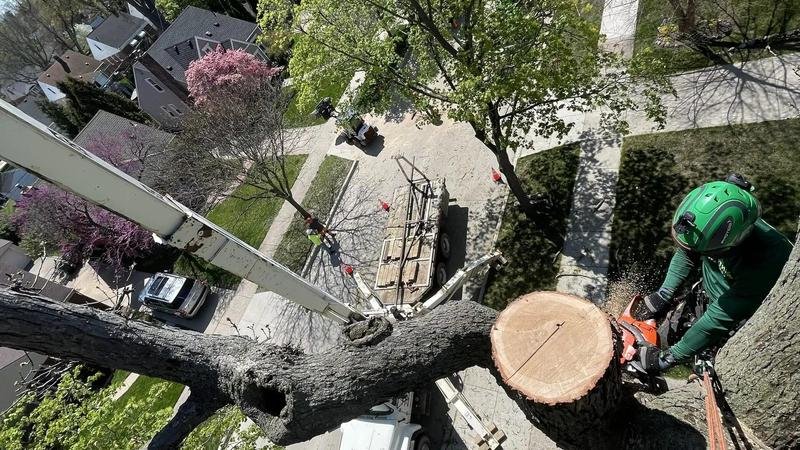Trees add beauty, shade, and value to your property. But sometimes, even the most majestic oak or towering pine becomes a liability rather than an asset. Knowing when and how to approach tree removal can save you thousands in property damage and ensure your family’s safety.
This guide will walk you through everything you need to know about tree removal—from identifying warning signs to choosing the right professionals for the job. Whether you’re dealing with storm damage or planning a landscape renovation, you’ll know how to make informed decisions about your trees.
Signs Your Tree Needs Professional Removal
Not every unhealthy tree requires immediate removal, but certain warning signs demand urgent attention. Learning to spot these red flags can prevent accidents and costly damage to your property.
Structural Issues That Can’t Wait
Dead or dying trees pose the most significant risk. Look for branches without leaves during the growing season, brittle bark that falls off easily, or fungal growth around the base. These symptoms often indicate internal decay that compromises the tree’s structural integrity.
Leaning trees also warrant immediate evaluation. While some trees naturally grow at slight angles, sudden changes in position after storms or gradual shifts exceeding 15 degrees from vertical suggest root damage or soil instability.
Cracks in the trunk, especially those extending deep into the wood, signal serious structural problems. Similarly, trees with multiple trunks or large, heavy branches overhanging structures create ongoing hazards that professional assessment can address.
Root Problems and Foundation Concerns
Underground issues often cause the most expensive damage. Roots growing too close to your home’s foundation can create cracks and compromise structural stability. Signs include uneven floors, stuck doors and windows, or visible foundation cracks.
Severed roots from construction activities weaken trees significantly. If more than 25% of a tree’s root system has been damaged, removal might be necessary to prevent the tree from falling unexpectedly.
Disease and Pest Infestations
Certain diseases and pest problems make trees unsalvageable. Emerald ash borer, Dutch elm disease, and sudden oak death are examples of conditions that typically require tree removal to prevent spread to healthy specimens.
Professional arborists can distinguish between treatable conditions and those requiring removal. Early intervention saves money and preserves the health of surrounding vegetation.
Understanding the Tree Removal Process
Professional tree removal involves much more than simply cutting down a tree. Understanding the process helps you prepare and ensures you’re working with qualified contractors.
Initial Assessment and Planning
Reputable tree removal companies begin with a thorough site evaluation. Professionals assess the tree’s condition, proximity to structures, utility lines, and potential obstacles. This assessment determines the removal method and equipment needed.
Tactical trees—those requiring specialized removal techniques due to location or condition—demand experienced professionals with proper equipment. Standard tree removal might involve felling the entire tree at once, while tactical removal requires piece-by-piece dismantling.
Safety Protocols and Equipment
Professional tree removal requires specialized equipment, including chainsaws, rigging systems, cranes, and personal protective equipment. Certified arborists follow strict safety protocols to protect property and personnel during removal.
Proper insurance coverage protects you from liability if accidents occur. Always verify that contractors carry both general liability and workers’ compensation insurance before beginning work.
Cleanup and Disposal
Complete tree removal includes debris cleanup and proper disposal. Professional services typically include cutting the tree into manageable pieces, removing all branches and logs, and grinding the stump below ground level.
Some companies offer additional services like wood chipping for mulch or cutting logs into firewood. Discuss these options during your initial consultation to understand what’s included in your quote.
DIY vs. Professional Tree Removal
The decision between tackling tree removal yourself or hiring professionals depends on several factors, including tree size, location, and your experience level.
When DIY Makes Sense
Small trees under 10 feet tall, located away from structures and power lines, might be suitable for DIY removal. You’ll need basic tools like a chainsaw, safety equipment, and help with cleanup.
However, even small tree removal carries risks. Falling branches can cause injury, and miscalculating the tree’s fall direction can damage property. Consider your skill level honestly before proceeding.
Why Professional Removal Is Usually Worth It
Large trees, those near buildings or power lines, and diseased or damaged specimens require professional expertise. The cost of professional removal often proves less expensive than repairing damage from DIY mistakes.
Professional services also handle permits when required. Many municipalities require permits for removing trees above certain sizes or in protected areas. Professionals understand local regulations and can navigate the permitting process.
Cost Considerations
Tree removal costs vary widely based on size, location, and complexity. Small trees might cost $200-500 to remove, while large specimens can cost $1,000-3,000 or more.
Factors affecting cost include tree height and diameter, proximity to structures, accessibility for equipment, and local disposal fees. Get multiple quotes and ensure all estimates include the same services for accurate comparison.
Choosing the Right Tree Removal Service
Selecting qualified professionals protects your property and ensures safe, efficient removal. Taking time to research contractors prevents costly mistakes and potential legal issues.
Essential Qualifications to Look For
Certified arborists possess specialized training in tree care and removal. Look for certifications from organizations like the International Society of Arboriculture (ISA) or Tree Care Industry Association (TCIA).
Proper licensing varies by state and municipality. Verify that contractors hold required business licenses and check their standing with local authorities.
Questions to Ask Potential Contractors
Request detailed written estimates that specify exactly what services are included. Ask about cleanup, stump removal, and debris disposal to avoid surprise charges.
Inquire about their approach to tactical trees if your situation requires specialized removal techniques. Experienced contractors can explain their process and address your specific concerns.
Check references from recent customers and verify insurance coverage independently. A reputable company provides proof of insurance willingly and maintains good relationships with past clients.
Red Flags to Avoid
Door-to-door solicitation often indicates unprofessional services. Legitimate tree care companies typically maintain full schedules through referrals and don’t need to canvas neighborhoods.
Extremely low bids compared to other estimates might indicate corner-cutting on safety, insurance, or proper cleanup. Similarly, demands for full payment up front suggest potential scam operations.
Planning for the Aftermath
Tree removal creates opportunities for landscape improvement and requires consideration of the space left behind.
Stump Removal Options
Stump grinding eliminates visible remains and allows replanting in the same location. This process reduces stumps to wood chips several inches below ground level.
Chemical stump removal takes longer but costs less than grinding. This method involves drilling holes and applying chemicals that accelerate decomposition over several months.
Landscape Restoration
Removing large trees creates opportunities to redesign your landscape. Consider factors like sun exposure changes, soil conditions, and your long-term landscaping goals before replanting.
New plantings should account for mature size and growth patterns. Professional landscape designers can help create plans that enhance your property’s value and appeal.
Taking Action: Your Next Steps
Tree Removal is a critical investment in your property’s safety, value, and long-term health. When a tree poses a risk, having it evaluated by certified professionals ensures the right decision is made based on expert recommendations. While cost is a consideration, prioritize quality, insurance coverage, and reputation over the lowest bid to protect your home and loved ones. Establishing ongoing relationships with qualified arborists also allows for preventive care that reduces future risks, maintains property value, and keeps your landscape safe and beautiful. Professional tree removal provides peace of mind, efficiency, and results you can trust.









